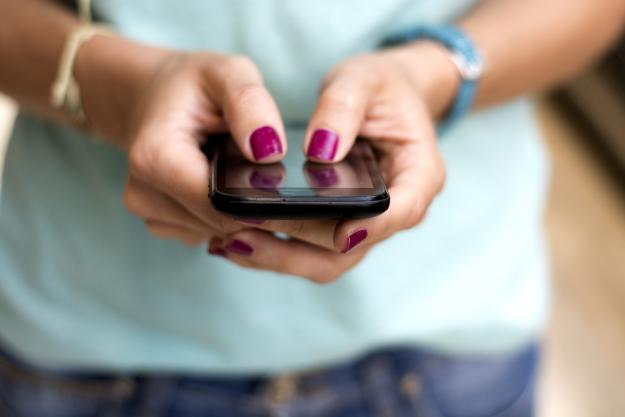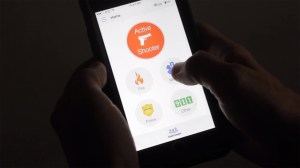Anonymous tip apps aim to help students stay safe

While the debate over how to prevent school shootings only seems to get more complicated in Washington, there are ideas that don’t require any action from Congress or the president. When it comes to discreetly collecting information about threatening behavior, mobile applications have shown some promise for school districts and law enforcement agencies.
One of the most recently launched apps, called Say Something, is the product of Sandy Hook Promise — a national nonprofit formed by the families of victims in the 2012 shooting at Sandy Hook Elementary School in Newtown, Connecticut. Their goal isn’t just to help authorities intercept violence — the app is also geared toward addressing whatever might be driving any aggression.
Say Something allows users to send anonymous tips if they are concerned about the behavior of a student or peer. A quick search of Apple’s App Store reveals several other applications with similar functions — some built for transit systems, airports and other institutions — but Say Something wants to address the underlying causes behind a potential threat, not just the threat itself, said Tim Makris, founder and managing director of Sandy Hook Promise.
“We want to create that generation that says something when they see some at-risk behavior around them,” Makris told EdScoop.
Through threat assessment training courses that it offers
each school, Sandy Hook Promise hopes to encourage school-led intervention that
deters a student from acting in a similar manner again, Makris said. That means instead of simply suspending a student for making a threat, a school might work with the student and provide resources to help them overcome challenges faced at home or at school that are driving the student
to exhibit risky behavior.
See more on student safety and security in this EdScoop Special Report
Anonymous tips have been a staple of law enforcement information-gathering for decades, but grade school students aren’t often encouraged to inform law enforcement if they’re feeling uneasy about a teacher or fellow student’s behavior. With mobile applications enabling easy-to-use anonymous tipping, though, public safety is meeting kids where they live: on social media, said Steve Malone, superintendent of Becker Public Schools, located outside St. Cloud, Minnesota.
“It’s a wonderful communication tool,” Malone said. “Kids live in the social media world, and this is part of social media.”
Sorting out false positives
Since Say Something’s hard launch on March 22, Sandy Hook Promise has struck partnerships with over 200 schools to use the app, Makris said. He explained the process of submitting, evaluating and responding to a tip in three steps. The app, which is available to and encouraged for use by students, parents and faculty, requires the submitter to include the name of the school the tip is associated with.
When a new district adopts the app, Makris said, between 4 and 10 percent of students and faculty will submit a tip at least once during the school year. When the tip is received — by a 24/7 crisis center staffed with trained professionals, Makris added — it is triaged and placed into the category of “life safety” or “non-life safety,” with an optional, anonymous two-way dialogue between the crisis center employee and tipster.
Makris said that just one-half of 1 percent of tips are considered hoaxes or false tips, many of which come in the first 24 hours after a school encourages students to adopt the app and are a byproduct of students testing it out. Say Something has yet to encounter a purposely false “life safety” tip, he said, but the language used on its website notes that all submissions are communicated to the proper authorities. Some other anonymous reporting systems, like Gaggle, have similar functions, but sort out false positives prior to forwarding the tip.
“We have to leave it to the district to investigate and take their own actions,” Makris said. “Our role is to get the tip to them. If they’re finding out that kids are ‘swatting’ kids, to use the term loosely, it’s up to them as to what steps they would want to take with or without working with us.”
The crisis center communicates the tip to the district based on how it would like to receive the tip; a life safety tip might go back to a local police dispatch, the related school and a district-level crisis team, while a non-life-safety tip might get texted and emailed directly into the school’s multi-disciplinary threat assessment team, which Sandy Hook Promise trains and requires each participating school to create within its faculty. The schools are then prompted to inform the crisis center that the tip is being handled.
Emphasis on intervention
Makris said he believes school shootings have already been prevented through the hundreds of thousands of tips that the platform has received — in part, he said, because of the intervention measures that Sandy Hook Promise encourages schools to take when they train faculty in threat assessment techniques.
Malone, who said his district had anonymous reporting enabled on its websites but not on any other platforms, decided that now is the time to provide students with more opportunity. Becker Public Schools partnered with the Say Something app in late May.
“I just think with the national concerns about school safety, there’s a heightened awareness by students that they need to take some responsibility,” Malone said, “and a heightened interest in students that they can make a difference.”
Sandy Hook Promise partnered with a vendor to design the app’s platform, which is a customized and nationally available version of the “Safe2Tell” and “Okay2Say” apps available in Colorado and Michigan. Makris said those programs, while effective, didn’t want to expand to a national market.
Say Something — available for every school district in the country — is being marketed to middle and high school students, but Makris said there’s no reason it couldn’t be applied to higher education as well.
Some universities and school districts have developed or are in the process of developing their own anonymous tip apps. The University of Utah offers its own anonymous reporting app, while Boston Public Schools is designing one to release next year.
To adopt the app, every school is required to embed a “Students Against Violence Everywhere” program — an anti-violence club Makris likened to “Students Against Destructive Decisions,” or SADD — within its extracurricular offerings. Makris compared the notion of designated drivers, which SADD helped popularize in schools in the 1980s and 90s, to what he hopes can be accomplished with school shooter warning signs and anonymous tipping.




